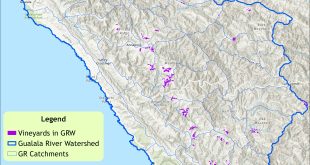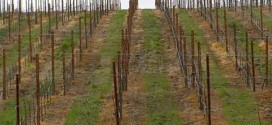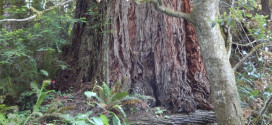| A version of this article was published in the Independent Coast Observer on January 27, 2006. |
Forest vineyards:
Timber regulations go to Sonoma Co. Supes
By Julie Verran
Courtesy Independent Coast Observer, Gualala, CA
Sonoma County has moved closer to regulating conversion of timberland to vineyards. A county use permit would be required in addition to existing state forestry permits.
The Board of Supervisors will act on the ordinance Tuesday, Feb. 7.
Chief planner Greg Carr said Wednesday in a telephone interview that it is up to the county attorneys whether the public will be allowed to speak at that meeting.
On Thursday, Jan. 19, the Sonoma County Planning Commission voted unanimously to send a draft timberland regulation ordinance to the Board of Supervisors. In June, 2005, the planning commission had voted 3-2 against timberland regulation. The commission’s recommendations were not available in writing by press time.
Most land so far converted from forest to vineyard in Sonoma County, or proposed for conversion, is in the Annapolis and Cazadero area inland from Sea Ranch, Stewarts Point and Timber Cove. Residents of the rest of the county are worried that forests in their areas will be targeted for vineyard conversion.
Other land in the mountains between Highway 1 and Highway 101 that was orchard, pasture, or oak woodland is now in vineyards or proposed for them. [See related Associated Press story by Terence Chea on Page 3.]
A BOS hearing in August drew about 200 people, of whom 50 spoke, mostly in favor of strong regulation or outright prohibition of vineyard conversions. The BOS asked staff to prepare a draft ordinance for review.
The main speaker representing vineyard interests at the August hearing was Richard Wollack of Premier Pacific Vineyards, a San Francisco financier who with his PPV partner, William Hill, secured about $200 million in funding from the California Public Employees Retirement System for Preservation Ranch, a 20,000-acre timberland holding where they propose planting about 2,000 acres of pinot noir grapes on ridge tops.
In December, the BOS adopted a resolution, and sent the issue back to the planning commission, in part because the California Department of Forestry let them know that the county could have a use permit for timber zoning districts, in addition to the Timber Harvest Plan and Conversion permit that CDF already requires.
Until then, the county was treading a narrower path between the state requirements. Other counties had passed timberland regulations that were struck down by courts.
The ordinance refers to the Forest Practice Rules, and uses forest site classes set by CDF on the basis of soil, water, and other conditions, by prohibiting conversion of Classes I and II, the prime forestlands, while requiring two acres of forest to be restored for every acre converted of other site classes.
“It’s like trying to weave a path through the forest,” Carr said Wednesday.
Friends of the Gualala River submitted a letter asking that the county strengthen the December draft to close potential loopholes. “The intent of the ordinance and the public outpouring of support has been to put protections in place to preserve the remaining timberlands and watersheds of Sonoma County from conversion and the multitude of potential environmental effects posed by this deforestation. […]
“If the county truly regards commercial agriculture incompatible on lands determined to be timberlands then this ordinance is fundamentally flawed. As written it does not protect those lands from conversion,” the letter said.
Last Thursday, the crowd at the meeting was about a dozen. Chair Dick Fogg allowed public comment. Jay Halcomb spoke first. He said the provision requiring two acres of timberland to be preserved for every acre of Class III to V forest converted should be restricted to a single ownership, not the “local area.”
Mike Sandler of the Community Clean Water Institute reminded the commissioners that most of the speakers at the August hearing wanted strong forest protection. That could be done by prohibiting conversion of site Class III, the largest class of forest in the county.
Although hundreds of people sent comments against it, the two-for-one swap is “still the centerpiece,” and needs to be dropped. Sandler added that “public benefit” should be spelled out more clearly, so landowners cannot claim a vineyard or winery as a public benefit. The forestland conversion issue is tied into water supply and global warming, Sandler concluded.
Prohibition of conversion for three of the five forest site classes would include about half the timber in the TP, RRD and RRDWA zoning districts, the majority of the forest in the county, said Larry Hansen of Town Hall Coalition. “Have the strongest language that you can for the forests of Sonoma County.”
Keith Kaulum spoke for Sierra Club. “We and other groups worked hard to convince the county that all vineyard conversions should be prohibited in forestland in the county.” He also asked a three-to-one acreage mitigation, or a prohibition of Class III conversion.
There are about 200,000 acres of forestland in the county, Kaulum said, with very limited development. If only 20,000 acres were redeveloped by conversion, that would be a heavy infrastructure burden, considering the industry standard of one worker for every six acres of vineyard. The Sierra Club proposes that an applicant be required to provide an economic analysis of the services needed by a conversion.
“If you build a road to an isolated area, who is going to maintain that road to a standard for trucks?” Kaulum said.
Petaluma rancher Al Gearhart said he was glad to see the environmentalists support commercial timber harvest and would like them to help reduce its regulatory burden. He wanted the possibility of reconverting to timber if grapes go down in price and timber goes up.
During discussion, Commissioner Dennis Murphy of Alexander Valley said the greatest loss of commercial timberland is to public acquisition for parks and open space.
Commissioner Rue Furch, who represents this district, asked for some recognition of the impact of conversions on biotic resources and riparian habitat.
Planner David Schiltgen is working on five recommendations from the commission to the Board.
That document should be posted on the county website “by mid-week,” Carr said just before press time Wednesday.
# # #
 Friends of Gualala River Protecting the Gualala River watershed and the species living within it
Friends of Gualala River Protecting the Gualala River watershed and the species living within it


